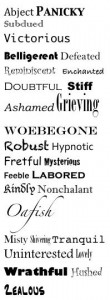Playful With A Hint of Brooding
 The college students are one month away from the EAC Fall Piano Recital. Some of them have never played in a hall before much less on a beautiful instrument. There is a sense of excitement mixed with a certain amount of uncertainty in the studio. Nearly everyone has moved past the nitty gritty at this point in the semester. We can finally begin to focus on what they want to say—on speaking together with the composer.
The college students are one month away from the EAC Fall Piano Recital. Some of them have never played in a hall before much less on a beautiful instrument. There is a sense of excitement mixed with a certain amount of uncertainty in the studio. Nearly everyone has moved past the nitty gritty at this point in the semester. We can finally begin to focus on what they want to say—on speaking together with the composer.
To that end, we have started a studio project involving adjectives. We are collecting and categorizing adjectives to create a reference to aid pianists in describing and understanding the character within repertoire. A student and I got this idea from a wonderful reference handout (now dog-eared and very, very faded) by Maurice Hinson which consists of an entire page full of adjectives.
Over the years, through discussions and activities, countless students and I have discovered and explored musical emotion and character using this little sheet. My favorite activity has always been one in which one student must choose adjectives to devise a mood in which another student must play a scale, arpeggio, progression, short improvisation etc.
One evening, during a partner lesson, we all giggled when a 15 year old girl seemed to channel Beethoven. Her description went something like this- Playful but never giddy with a mere hint of brooding. Of course this activity is loads of fun. But on the serious side, not only do students really have to know their musical elements, they must also conceive of the sound they want in their heads while at the same time listening out into the room. Artistry is at the fore.
To further our forward motion in the interpretive, each student is also in the process of listening to 4 – 5 performances of their recital piece and then describing and comparing them on a handout. They are asked about what they liked and didn’t, the details of repeated sections, dynamics, and expression, and how they think the artist used musical elements to convey a personal view.
At first this is very difficult for some. I have had students schedule root canals rather than complete this activity. Some resent the time it takes, some fail to see the value or possibilities in learning about a piece away from the keyboard, some are threatened by the musical viewpoints of others, some simply have no experience thinking that deeply about music. But, those who put their whole selves into this activity begin to discover the wonder that is interpretation and their own beautiful voices.
When students have something true and real to say through a piece, fear takes a back seat and there is room for the recital experience to be a positive one. When an audience member or colleague comments in an insightful way about the performance—say they appreciated the way it was playful with a hint of brooding—any mishaps along the way fade right into obscurity.



Here’s an update on our adjectives project. We have started a Wiki to make it easy to work on our adjectives project. Right now only students and a few mentors can edit or contribute. You can view the Musical Adjectives Project Wiki by clicking on the link in the top right corner of any page on this blog.
No school laptops but we have a great music workstation lab with digital pianos hooked up to computers. Most of the students do have their own laptops though.
er… DO EAC students… 🙂
What a great idea!
So EAC students receive laptops issued by the school?
Forgot to mention that part of our project is a blog post with all the adjectives. This is a year long project and it isn’t clear yet whether we will be posting the lists in several parts or all at once.
Hi Gail,
Sounds wonderful! The more concrete the better. The ability to describe things can be so elusive when it comes to putting it music into words.
How can you convey an emotion if you can’t name it?
(BTW, I had to learn how myself. It was well worth the effort.)
Gretchen
Thanks for another provocative post!
I love it!
Not only will this activity of listing and then performing adjectives be improving the interpretative range of the students, but it will be deepening their emotional literacy as well!
And as for the activity comparing a range of different performances of the same work – what a wonderful way of demonstrating just how much the performer is a creative partner in the process of bringing the work to reality.
Fabulous.